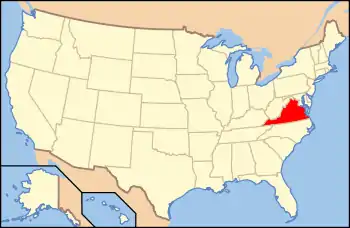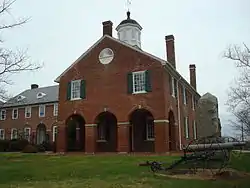Hope Park
Hope Park was an 18th and 19th-century plantation in Fairfax County in the U.S. state of Virginia. Hope Park was the residence of Dr. David Stuart (1753–1814), an old friend and associate correspondent of George Washington, and second husband of Washington's former stepdaughter-in-law, Eleanor Calvert Custis (1758–1811).[1] Hope Park Plantation was located approximately 5 miles (8.0 km) southwest of Fairfax Court House (now known as the independent city of Fairfax).[2][3]
| Hope Park and Hope Park Mill | |
|---|---|
Hope Park Plantation | |
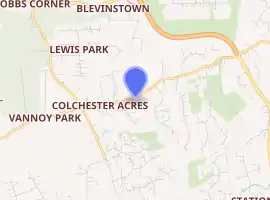
| |
| General information | |
| Type | Private residence/business |
| Location | Fairfax County, Virginia |
| Town or city | Fairfax |
| Country | United States |
| Current tenants |
|
| Owner | Hope Park Plantation
Hope Park Mansion
Hope Park Mill/Miller's House
|
History
Payne family
The plantation at Hope Park was founded in the 1750s by Edward Payne, a justice of the Fairfax County Court from 1764 to 1785 and builder of Payne's Church which was completed in 1778.[4] Payne served with George Washington and George Mason on the Truro Parish vestry and the then, Washington, occasionally resided with the Paynes at Hope Park. Payne is also credited with constructing a small grist mill, probably on Piney Branch which was on the Hope Park property.[4][5] A mill would have been an important adjunct to the plantation.[5]
Stuart family
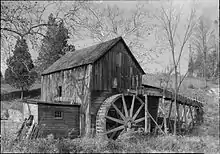
Dr. David Stuart purchased Hope Park plantation in 1785.[3][6] Stuart was an Alexandria physician who was appointed on January 22, 1791, by then President Washington, as the member representing Virginia on the first board of Commissioners of the Federal City and he served for almost four years.[3][6] In 1789, Stuart served as a justice for the Fairfax County Court.[6] Stuart was also later named a trustee by the Virginia General Assembly for the towns of Centreville in 1792 and Providence (later known as Fairfax Court House, and then Fairfax) in 1805.[6]
Stuart married Eleanor Calvert Custis, widow of John Parke Custis and daughter-in-law of Martha Washington and stepdaughter-in-law of George Washington, in 1783.[6][7] Until relocating to Hope Park sometime between 1791 and 1793, the couple resided first at Custis's Abingdon plantation overlooking the Potomac River.[1][6][8] Estates along major waterways found transport and communication easier than those in the interior of Fairfax County such as Hope Park.[4] The Stuarts regularly received George and Martha Washington as guests at Abingdon and at Hope Park plantation and were frequent guests at Mount Vernon.[7][8] Because of the close relationship between the Stuart and Washington families, Hope Park is mentioned frequently in Washington's correspondences and diaries.[7][8]
Stuart's stepdaughters and George Washington's step-granddaughters Martha Parke Custis and Elizabeth Parke Custis were both married at Hope Park. Martha Custis married Thomas Peter on January 6, 1795, and Elizabeth Custis married Thomas Law on March 20, 1796.[3][7] When the Stuart's moved to Hope Park, these elder Custis daughters moved with them and lived there with their mother and stepfather.[7] Peters was the son of a successful Georgetown merchant and Law was the son of Edmund Law, Bishop of Carlisle, and the younger brother of Edward Law, 1st Baron Ellenborough, George Henry Law, later Bishop of Bath and Wells, and John Law, a Church of Ireland bishop.[7][9][10] The Custis/Law union was a short one and ended in divorce in 1806. While the two younger Custis siblings, Eleanor Parke Custis and George Washington Parke Custis, lived at Mount Vernon, Philadelphia, and New York with George and Martha Washington, they also visited their mother at Hope Park.
Most likely under Stuart's ownership and before the Stuart family relocated to Ossian Hall in 1804, a second mill and was constructed on the west bank of Piney Branch. An adjacent miller's house was also built.[5][11] The precise dates of construction of this mill and the miller's house are unknown, but the mill was mentioned as being "in complete repair" in an 1815 sale notice following Stuart's 1814 death.[5] A study of the mill undertaken in 1972 by preservationist Russell Wright placed the mill's construction at c. 1800.[5] Then known as "Hope Park Mill," it later gained importance as a neighborhood mill, serving the needs of adjacent plantations in central Fairfax County.[11]
Barnes family
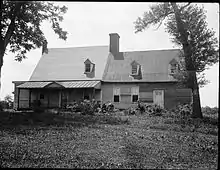
The bulk of the Hope Park plantation property remained in Dr. Stuart's estate until December 1837 when John H. Barnes, Sr. purchased a 1,000-acre tract which included the mill and miller's house but not the main Hope Park dwelling.[5] Barnes purchased the remainder of Hope Park plantation including the main dwelling house in February 1838.[2][5] The Barnes, Sr. family is the first known to have occupied the miller's house.[5] They subsequently moved into the main house and Barnes Sr. was the last to own Hope Park plantation as a consolidated entity. After Barnes Sr.'s death, Hope Park plantation was broken into eight inheritance properties when his estate was settled in 1853.
The late Barnes Sr.'s wife, Sarah Barnes, received the main Hope Park dwelling house with 194 acres which was referred to as the "Mansion House Tract." The Barnes' eldest son Jack Barnes (i.e., John H. Barnes, Jr.) had been trained as a miller and he and his wife, Mary Fox Barnes, were given property including the mill and miller's house which they occupied and called "Huntley."[5] Barnes Sr.'s other six children received other Hope Park plantation parcels.
As Hope Park plantation grew in prosperity under the Barnes family, so did its slave population.[2] In the 1840s, the Barnes family owned four slaves, seven in 1850, and 12 in 1860.[2] Due to the outlay and high cost of slaves, the number of slaves owned by the Barnes family was relatively low in comparison to the slave workforces at neighboring plantations in Fairfax County.[2] Barnes, Sr. had the aid of his sons in working the plantation, which was also a factor in lessening the family's dependence upon slave labor.[2]
American Civil War
Following the onset of the American Civil War in June 1861, John Barnes's three sons, including Jack (then 29 years of age), traveled from Hope Park to Fairfax Court House to enlist in the 17th Virginia Volunteer Infantry Regiment, known as the "Fairfax Rifles."[2][5] Two months later, Jack Barnes was captured and sent to the Old Capitol Prison in Washington, D.C. (the first of Barnes' three Federal incarcerations).[5]
The remaining Barnes family members (widow Sarah and her four daughters and Jack Barnes' wife, Mary, and their children) and slaves were temporarily forced to evacuate Hope Park and Huntley.[2][5] Upon their return a short time later following the Confederate victory at the First Battle of Bull Run, the family found its residences at Hope Park and Huntley still standing, however, they had been vandalized by Union soldiers.[2][5]
During the winter of 1861/1862, Hope Park Mill was used by Confederate States Army forces as Post No. 3.[11] Shortly after the Confederate States Army forces vacated Hope Park Mill in March 1862, Union Army forces advanced into western Fairfax County to conduct foraging and resupply operations against civilians.[2] Union soldiers confiscated everything they could carry, including vegetables and pigs.[2] One of the confiscated pigs belonged to ten-year-old Nettie (Jack and Mary Barnes' daughter), who according to the Barnes family story, recovered her pig from the Union raiding party.[2] The following is an excerpt from the Barnes family's account of the story in Charles V. Mauro's The Civil War in Fairfax County: Civilians and Soldiers:
The Yankee officer asked Nettie if she could point out the soldier who had taken her pig. She said she could. So the officer lined up the raiding company up in front of Nettie and she quickly picked out the guilty one. The officer didn't order the man shot, but he did order him to return the pig post-haste. The soldier saluted, got the pig and carried it back to our home, with Nettie and the servant trudging along beside him.[2]
Robey family
The mill at Hope Park prospered again around the turn of the 20th century under the ownership of Frank Robey.[11] Robey's death in 1916 brought an end to Hope Park Mill's commercial production.[11]
Current status
Hope Park Mill and Miller's House | |
 | |
| Location | 12124 Pope's Head Road Fairfax, Virginia |
|---|---|
| Coordinates | 38°48′51″N 77°22′0″W |
| Area | 30.1 acres (12.2 ha) |
| Built | c. 1800 |
| NRHP reference No. | 77001486[12] |
| VLR No. | 029-0064 |
| Significant dates | |
| Added to NRHP | August 15, 1977 |
| Designated VLR | November 16, 1976[13] |
Hope Park mill and miller's house (sometimes known collectively as "Robey's Mill" or "Piney Branch Mill"), along with a log smokehouse, spring house, and cabin, are preserved.[11] Hope Park's mill and adjacent ancillary buildings were listed as "Hope Park Mill and Miller's House" on the Virginia Landmarks Register on November 16, 1976, and on the National Register of Historic Places on August 15, 1977.[11] Hope Park Mill and Miller's House are located at 12124 Pope's Head Road, Fairfax, Virginia.[5] At the time of the complex's listings in 1976 and 1977, the property was owned by Sally and David McGrath who also lived in the miller's house.[5]
The Hope Park mansion house and the mill were photographed by the Historic American Buildings Survey (HABS) in the 1930s. Detailed measured drawings of the mansion house were made in the 1930s, and of the mill in the 1970s; all can be viewed on the Library of Congress website. A plaque from the U.S. Department of the Interior commemorating this activity sits in the mansion house.
As of the time of this article's composition and subsequent to the Barnes' tenure, ownership of the Hope Park mansion house (and its fluctuating acreages due to sales or inheritances) has been held by, the Newmans, Zimmerman, the Mattinglys, the Flints, and the Warhursts. The Hope Park mansion house, as it has evolved over the years, remains in use as a private residence and shares a seven-acre lot with a grand modern home about a mile from the mill and miller's house. Until 1976 when the remaining 82-acre Hope Park "Mansion House Tract" was subdivided, the address of the mansion house was 11807 Pope's Head Road. It obtained a new address then when the old farm lane from Popes Head Road to the mansion house was named to accommodate the development.
References
- National Genealogical Society (1922), National Genealogical Society Quarterly, Volumes 7-9, National Genealogical Society
- Mauro, Charles V. (2006), The Civil War in Fairfax County: Civilians and Soldiers, The History Press, ISBN 1-59629-148-6
- Clark, Allen Culling (1901), Greenleaf and Law in the Federal City, Press of W. F. Roberts
- Netherton, Nan (1978), Fairfax County, Virginia: A History, Fairfax County Board of Supervisors, ISBN 0-9601630-1-8
- David, Elizabeth S.; Fairfax County Office of Comprehensive Planning (1977), National Register of Historic Places Inventory – Nomination Form (PDF), Virginia Department of Historic Resources
- Jensen, Merrill; Gordon DenBoer (1984), The Documentary History of the First Federal Elections, 1788-1790, University of Wisconsin Press, ISBN 978-0-299-09510-9
- Baker, William Spohn (1898), Washington After the Revolution: MDCCLXXXIV-MDCCXCIX, J. B. Lippincott Co.
- Historical Society of Pennsylvania (1897), The Pennsylvania Magazine of History and Biography, Volume 21, Historical Society of Pennsylvania
- Arlis Herring (9 February 2008). "Elizabeth Parke Custis". Retrieved 2008-02-28.
- "The Papers of George Washington: Documents". 2009. Archived from the original on 2007-08-29. Retrieved 2008-02-28.
- Loth, Calder; Virginia Department of Historic Resources (1999), The Virginia Landmarks Register, University of Virginia Press, ISBN 0-8139-1862-6
- "National Register Information System". National Register of Historic Places. National Park Service. July 9, 2010.
- "Virginia Landmarks Register". Virginia Department of Historic Resources. Retrieved 5 June 2013.
External links
- Historic American Buildings Survey (HABS) No. VA-107, "Hope Park, 11807 Pope's Head Road, Fairfax, Fairfax City, VA", 9 photos, 6 measured drawings, supplemental material
- HABS No. VA-741, "Piney Branch Water Mill, 1212 Pope's Head Road, Fairfax, Fairfax City, VA", 3 photos, 5 measured drawings

